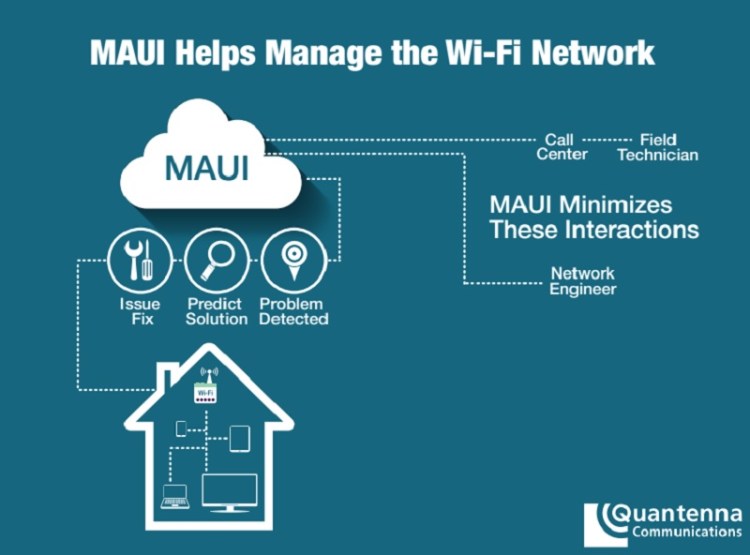Normally, if your Wi-Fi network goes down, your only option is to check the wiring and then complain. But Quantenna Communications, a maker of super-fast Wi-Fi chips, is unveiling a new data analytics service called Maui that will allow service providers to figure out if something is amiss with a consumer’s home Wi-Fi wireless network before anyone has to file a complaint.
The technology is built into the networking cloud, and it helps guarantee better uptime for Wi-Fi networks. Quantenna is demoing the service at the 2015 International CES tech trade show in Las Vegas this week. Maui enables service providers to deliver real-time, automated Wi-Fi network monitoring, optimization, and self-healing for customers around the clock.
“Maui puts intelligence in the cloud to monitor each individual Wi-Fi network in the home,” James Chen, senior director of marketing at Quantenna, told VentureBeat. “The benefit is it predicts problems before the consumer makes a service call to the service provider. It connects to your network, looks at Wi-Fi data, not application data, that is being exchanged between the gateway and individual clients.”
Service providers will like this because their customers will be happier and will be able to handle some of their own problems. The service providers won’t have to take as many complaint calls, and they won’t have to send out as many trucks for repairs. And that saves a lot of money.
“With the increasing number of wireless devices in the home, it’s critical to have a reliable Wi-Fi network,” Sam Heidari, CEO of Quantenna, said in a statement. “Consumers will now be able to hook up the Wi-Fi equipment sent by their service provider and have the peace-of-mind that their equipment is constantly being optimized to operate at its maximum potential.”
Maui diagnoses problems and makes fixes automatically, without the customer even knowing there is a problem. It can detect issues such as peak traffic bottlenecks or poor router placement within the home. Maui is available for service providers and is being tested now in various markets.
“Maybe there’s some interference and it can deal with that,” Chen said. “It can adjust performance settings to change to a different channel and reduce the problem.”
It’s an unusual service for a chip company, but Quantenna’s whole ambition is to make Wi-Fi better.
Quantenna is also showing off at CES a new Wi-Fi chip technology that can double the speed of wireless networks. The new 10G Wi-Fi platform uses what Quantenna says is the first True 8×8 MIMO, a new technology for sending a lot more data simultaneously over eight streams within a wireless signal. Chen said Quantenna is showing off a prototype of its True 8×8 MIMO technology at CES, which can operate with a throughput of 6.8 gigabits per second to 10 gigabits per second.
At 10 gigabits a second, Quantenna-based 10G Wi-Fi networks could operate faster than many wired connections, particularly those based on phone lines and dubbed DSL (digital subscriber lines). It will make the Internet work faster in homes, small businesses, enterprises, and public spaces.
The MIMO technique lets Quantenna cram more data into a wireless network by taking advantage of noise (via beamforming) that would normally cause interference.
“The trend is all about massive MIMO and how we can increase spectral efficiency by adding more MIMO channels,” Chen said.
Most Wi-Fi is around 1.7 gigabits a second on 5 gigahertz wireless signals. But Quantenna can do much more than that by sending a lot more data simultaneously over different streams. Previously, Quantenna could handle four streams at a time.
That’s important because data traffic is growing exponentially on Wi-Fi networks. Half of the Internet’s traffic is expected to run through Wi-Fi by 2018, according to the 2014 Cisco VNI report. Also, the number of Internet-enabled devices in the home is increasing and is expected to reach 25 per home in 2017, according to OECD.
Quantenna recently raised $22 million in funding from Centerview Capital Technology, Vivint, NTT Group, Sequoia Capital, Venrock, Sigma Partners, Southern Cross Venture Partners, DAG Ventures, and Rusnano. Rivals include Qualcomm-Atheros, Broadcom, and Marvell. Those companies are all much bigger than Quantenna, but its focus on high-end technology has helped it.
VentureBeat's mission is to be a digital town square for technical decision-makers to gain knowledge about transformative enterprise technology and transact. Learn More

